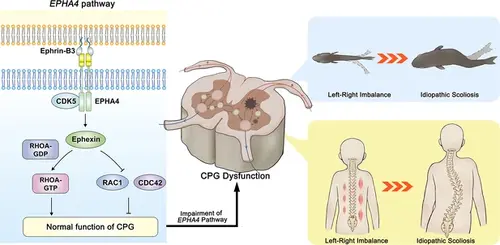Fig. 9
- ID
- ZDB-FIG-250807-42
- Publication
- Wang et al., 2025 - EPHA4 signaling dysregulation links abnormal locomotion and the development of idiopathic scoliosis
- Other Figures
- All Figure Page
- Back to All Figure Page
|
The proposed mechanism of idiopathic scoliosis (IS) mediated by EPHA4 dysfunction. In healthy individuals, EphrinB3-activated EPHA4 phosphorylates CDK5, leading to the phosphorylation of Ephexin, a protein encoded by NGEF. Phosphorylated Ephexin can regulate axon guidance through either activating RHOA or suppressing CDC42 and RAC1 signaling. These processes are critical in maintaining the normal function of the central pattern generator (CPG), the local neural network that provides coordinated bilateral muscle control. Impairment of the EPHA4 pathway and CPG may cause an imbalance of the motor drive from the spinal cord during development, thus causing the uncoordinated left/right swimming behavior in zebrafish larvae and the asymmetry of the bilateral muscular pull in a young child. Although the appearance is normal in early childhood, the dysfunction produces a scoliotic curve during the growth spurt. |

